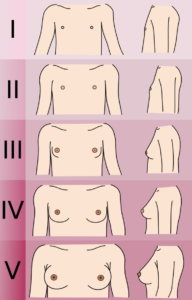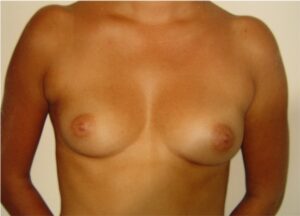Several breast growth patterns can be troubling to the adolescent and her family. Among these are:
Unusually early breast development
- Unusually delayed breast development
- Unusually large breasts (Mammary hypertrophy)
- Unusually small breasts
- Asymmetrical breast growth
- Breast lumps

Initial breast development occurs on average at age 9, with the appearance of a breast bud. The normal range for breast bud appearance is from age 8-13. It is not rare for one bud to appear up to 6 months prior to the second bud appearing.
Breast growth is then progressive, with enlargement of the breast tissue, areala and papillae, and change in shape and contour. By age 18 breast development is usually complete.
Premature thelarche is breast development prior to the age of 8 (and in the absence of pubic hair development). These children are evaluated to rule out estrogen-producing ovarian tumors, ingestion of estrogen-containing compounds, and the rare, true precocious puberty.
Female Breast Development Scale (Tanner Stages)
-
Stage 1: No glandular breast tissue palpable
-
Stage 2: Breast bud palpable under the areola (1st pubertal sign in females)
-
Stage 3: Breast tissue palpable outside areola; no areolar development
-
Stage 4: Areola elevated above the contour of the breast, forming a “double scoop” appearance
-
Stage 5: Areolar mound recedes into single breast contour with areolar hyperpigmentation, papillae development, and nipple protrusion
From: Emmanuel M, Bokor BR. Tanner Stages. [Updated 2022 Dec 11]. In: StatPearls [Internet]. Treasure Island (FL): StatPearls Publishing; 2023 Jan-. Available from: https://www.ncbi.nlm.nih.gov/books/NBK470280/
Delayed thelarche reflects absence of any breast development by age 13.

Asymmetrical breast growth during adolescence is the rule rather than the exception. Reassurance is given that the asymmetry usually evens out by the time of full maturation. Even at maturity, breasts are rarely 100% symmetrical, so minor degrees of asymmetry are expected. Because the breasts are continuing to grow and change, surgical intervention for asymmetric breasts is generally delayed until after age 18.
Mammary hypertrophy can be a distressing symptom. Because growth and development continues for a long time, surgical intervention, if contemplated is postponed until the breasts are fully mature.
Breast masses in adolescents are essentially 100% benign. Because of this, surgery (excisional biopsy or fine needle aspiration) is almost never warranted. Further, the surgical disruption of architecture can be disfiguring as the breast continues to mature.
